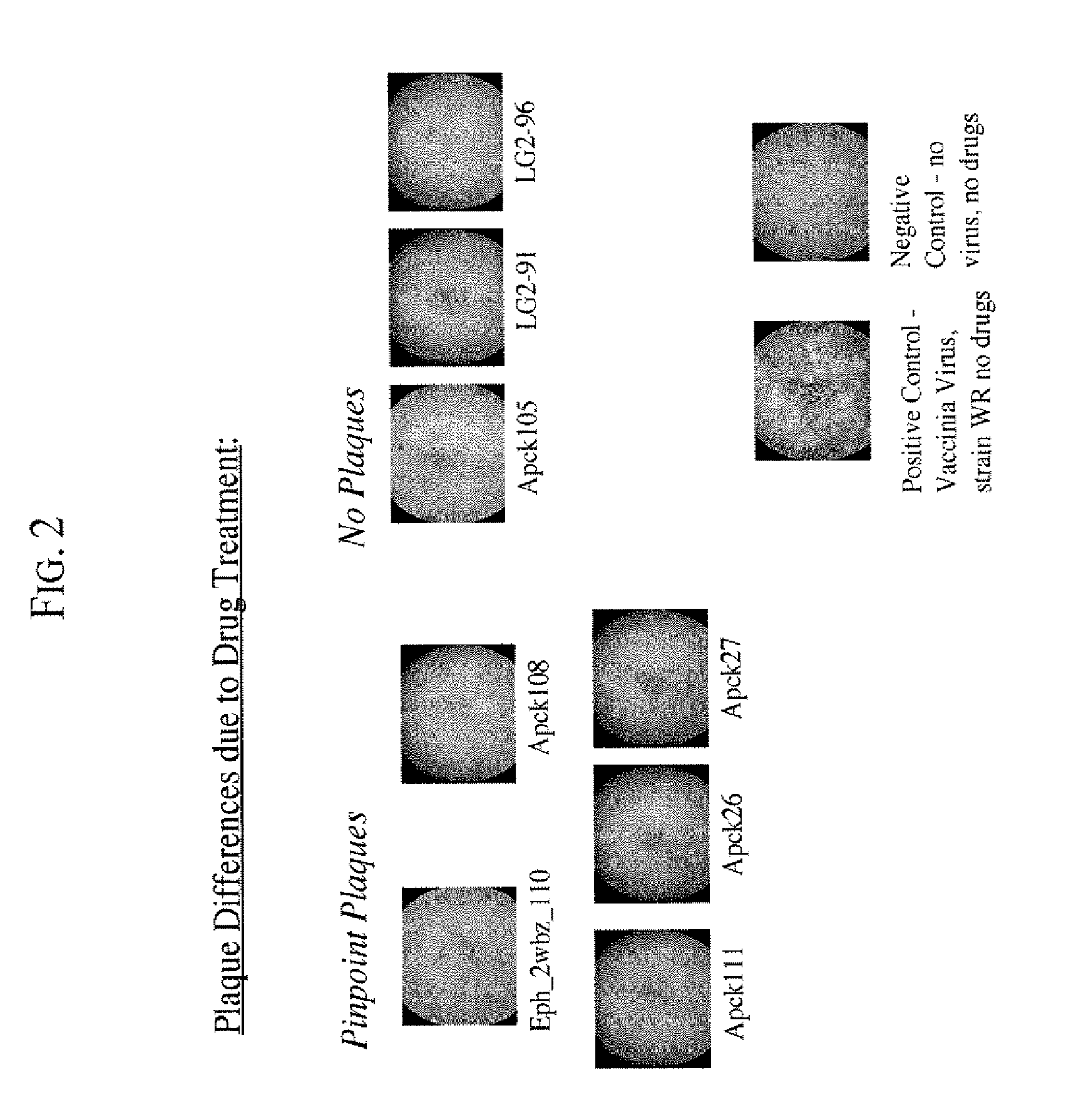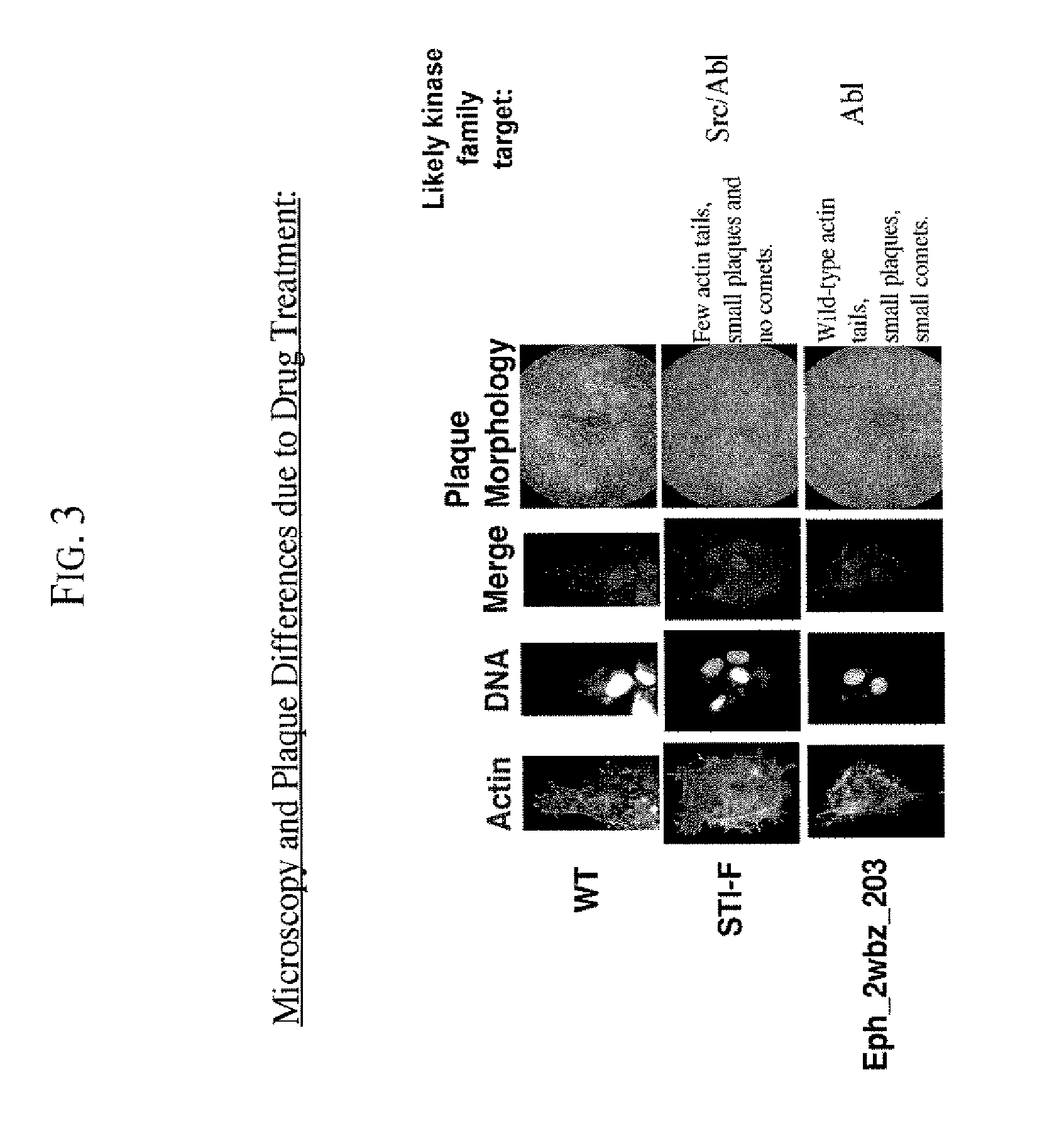Kinase Inhibitors for Preventing or Treating Pathogen Infection and Method of Use Thereof
- Summary
- Abstract
- Description
- Claims
- Application Information
AI Technical Summary
Benefits of technology
Problems solved by technology
Method used
Image
Examples
example 1
Drug Screening Using Microscopy Assays
The present invention provides drug screening assays for microbal pathogens. In one of the preferred embodiments, the present invention provides drug screening assays for viral pathogens, preferably, the poxviruses. Two exemplary drug screening assays: the microscopy assay and the Plaque Assay, are provided herein. The purpose of microscopy assays is to screen compounds in a high throughput format for their effects on the formation of actin protein filled membranous protrusions caused by vaccinia virus egressing from an infected cell (or “tails”). The microscopy assays also reveal, albeit indirectly effects on replication or viral maturation.
To do the microscopy assays, cultured 3T3 cells were added at a low density to collagen / PDL-coated glass microscopy slips or on 96 well optical tissue culture plates. The cells were allowed to adhere to these slips overnight. The next day, the media was removed from these cells and replaced with low-serum me...
example 2
Drug Screening Using Plaque Assays
The purpose of the plaque assays is to screen compounds for their effect on vaccinia virus plaque size, and on the formation of “comet” plaques, an archipelago of smaller plaques that form adjacent to a large plaque. Large plaques form as virus from an infected cell egresses, by means of actin protein tails, and infects an apposing cell. An infected cell eventually dies leaving a hole in the monolayer. Comet plaques occur when a form of the virus (called EEV) is released into the supernatant and settles adjacent to a large plaque. Comets are generally smaller than large plaques because the initial infection is derived from virus produced by an adjacent large plaque, not by the initial innoculum. To a small extent, the size of the large plaques is determined by EEV as well. Formation of actin protein tails (and thus the size of large plaques) depends on Src- and Abl-family kinases (Reeves et al., 2005, Nature Medicine. 11: 731-738), whereas the forma...
example 3
Drug Screening Assays for Herpes Virus
All herpes viruses share the property of establishing life-long infection in their host. Notably, the gamma-herpes viruses are all associated with the development of lymphomas and other cancers. To determine whether tyrosine kinases participate in gamma-herpes virus infections, confluent monolayers of 3T3 cells were exposed and plated in optical 96 well dishes to the library of compounds of the present invention described herein for 1 hour. The cells were then infected with a gamma-herpes variant that expresses GFP under a CMV promoter (GHV-Bac-GFP), and replaced the compounds of the present invention at final concentration of 10 μM.
After 7 days, control cells that were left untreated exhibited marked cytopathic effects, an effect attributed to the spread of the initial infection throughout the monolayer, and subsequent lysis of infected cells. Amongst compound treated cells, three phenotypes were evident: (i) compound treated cells showed evide...
PUM
| Property | Measurement | Unit |
|---|---|---|
| Time | aaaaa | aaaaa |
| Mass | aaaaa | aaaaa |
| Mass | aaaaa | aaaaa |
Abstract
Description
Claims
Application Information
 Login to View More
Login to View More - R&D
- Intellectual Property
- Life Sciences
- Materials
- Tech Scout
- Unparalleled Data Quality
- Higher Quality Content
- 60% Fewer Hallucinations
Browse by: Latest US Patents, China's latest patents, Technical Efficacy Thesaurus, Application Domain, Technology Topic, Popular Technical Reports.
© 2025 PatSnap. All rights reserved.Legal|Privacy policy|Modern Slavery Act Transparency Statement|Sitemap|About US| Contact US: help@patsnap.com



